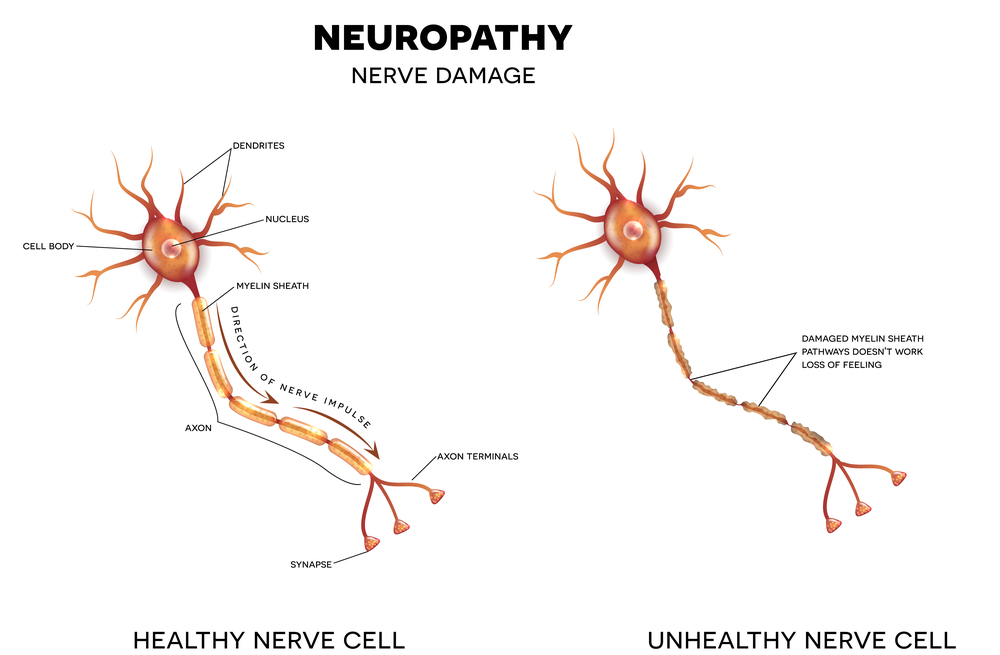Almost all adults struggle with lower back pain at some point in their lives. There are many causes of this chronic lower back pain, from nerve or joint damage to chronic disease to simple wear and tear.
One of the most challenging types of back pain to diagnose and treat, however, is lower back pain caused by peripheral neuropathy. When an individual suffers from a neuropathic injury, there are no scrapes or bruises to help with diagnosing the issue.
In fact, the pain is unrelated to any type of observable injury or condition. Instead, neuropathic pain is a type of nervous system condition where nerves send pain messages to the brain despite a lack of ongoing tissue damage. Understanding peripheral neuropathy can help you find the solutions you need for your pain.
What Is Peripheral Neuropathy?
Peripheral neuropathy is an umbrella term referring to a variety of conditions that involve damage to the peripheral nervous system. The peripheral nervous system is a network of nerves that send messages between your brain and spinal cord to other parts of your body. When your hands feel warm or your legs ache, it’s because this system sends those messages to your brain.
Oftentimes, neuropathic pain starts in the lower back and moves out toward your limbs because of nerve damage. This is how lower back injuries can quickly lead to peripheral neuropathy.
Most vitally, these nerves send signals to muscles telling them to contact. This is how we move, pump blood from our heart to muscles, digest food, and urinate. It also influences our bone health and immune system effectiveness. These nerves are the vital cables that are essential for complex functions of the body, and there are three different ways nerve signaling may be disrupted:
- Signals stopping or being diverted on their way to the brain
- Inappropriate or unnecessary signals when there should be none
- Errors in signaling that may distort messages (e.g., a feeling of cold when something is actually hot)
Researchers estimate more than 20 million people in the US suffer from peripheral neuropathy. However, these numbers may be much higher since many people with the condition haven’t been tested for it. Moreover, since neuropathy often presents such as a complex range of symptoms, it’s often misdiagnosed.
 How Does Neuropathic Pain Develop?
How Does Neuropathic Pain Develop?
After an injury or trauma, nerves can become damaged, resulting in pain hypersensitivity. These damaged nerves send false pain signals, even if there’s no injury in the affected area. Moreover, real causes of pain may be felt as even worse than they normally would.
Neuropathic pain (also known as neuropathy) often manifests as chronic illness. In these instances, there are treatment options, but no cure. This condition is also known as peripheral neuritis and sensory peripheral neuropathy, depending on the symptoms the individual experiences.
What’s the Connection Between Peripheral Neuropathy and Lower Back Pain?
There are several injuries and conditions in the lower back which may cause peripheral neuropathy. Most of the time, these result from compressed or stressed nerves. For example, a herniated disk may press against a nerve ending nearby, resulting in pain for both the lower back and limbs. Types of neuropathic pain originating from either the lower back or spine include:
- Conditions such as lumbar radiculopathy or sciatica, which cause pain that radiates down the lower back or legs.
- A pinched nerve, which can cause severe lower back pain when the affected nerve is in the lower spine.
- Pain resulting from back surgery and persists after (also know as surgery pain).
Other health conditions can also trigger lower back pain, including diabetes and regional pain syndrome. Finally, other causes of injury, infection, disease, and substance abuse may also be the origins of neuropathy.
In short, there are countless ways that you may develop peripheral neuropathy in your lower back. But the constant in all cases is that the sooner the issue is treated, the better.
Early Treatment is Essential
Early treatment is important for most conditions, but with peripheral neuropathy, it can make an even larger difference in your quality of life. In some cases, aggressive treatments may be necessary to forestall condition before even worse symptoms take effect.
Moreover, neuropathic pain can cause serious damage to your central nervous system. After prolonged periods of this, you could even develop a condition known as central sensitization where the body becomes sensitive to even light touch.
Moreover, similar to other conditions, delaying treatment can exacerbate other health problems including insomnia, depression, or anxiety. After all, it’s hard to focus on your sleep or mental wellbeing when you’re in near-constant pain.
What Are the Symptoms of Neuropathy?
Symptoms of neuropathy are unpredictable and vary greatly between individuals. Which peripheral neuropathy symptoms you experience will largely depend on the cause of your pain. For example, neuropathic pain caused by injury may not stay solely in the injured area.
Even the amount of pain changes from person to person. One person with a herniated disk may only feel pain while sitting in a certain position, where another could feel it all the time.
That said, most people with neuropathic pain experience a loss of mobility due to pain. This creates a downward spiral, as sedentary individuals lose muscle mass, which further restricts their motion. For this reason, many individuals with the condition may not be able to work.
Generally, individuals describe pain caused by neuropathy as:
- Deep
- Burning and/or cold
- Persistent numbness and tingling
- Severe shooting pain like lightning or stabbing
- Pain that travels through the limbs into hands and feet
The skin in affected areas may also appear discolored, sometimes blue or red. This is caused by changes in blood flow and swelling. Further, since many individuals with neuropathy experience depression and insomnia, the perception of pain is often increased.
How Do Doctors Test for Neuropathic Pain?


- Blood Test: These are used to detect conditions like diabetes, immune system dysfunction, vitamin deficiencies, and other causes of peripheral neuropathy.
- Imaging Tests: MRI, CT, and other tests can look for tumors, herniated disks, and other physical causes of neuropathic pain.
- Nerve Biopsy: Your doctor may remove a small nerve sample to check for damage.
- Nerve Function Tests: Electromyography (EMG) makes a record of electrical activity to check for nerve damage. To explain further, your doctor would check to see how an impulse travels throughout your body to identify potential nerve damage.
- Skin Biopsy: This is similar to a nerve biopsy. Your doctor will remove a small amount of skin to check nerve endings for any irregularities.
Peripheral Neuropathy Treatments
Since neuropathy is a chronic condition, your doctor may not be able to cure you of it. However, you can still manage the symptoms and greatly improve your quality of life. Doctors use a variety of treatment tools, including:
Peripheral Neuropathy Medications
- Analgesic: Over-the counter-pain medications such as anti-inflammatories can relieve mild neuropathy symptoms. For more severe cases, your doctor may prescribe prescription painkillers to help you deal with the pain.
- Topical Treatment: Many patients noticed symptom improvement after using capsaicin cream (the same substance found in chili peppers). Another useful tool is lidocaine patches. The skin absorbs each of these treatments, which leads to pain relief.
- Anti-Seizure Medications: Scientists originally designed anti-seizure medications for people with epilepsy, but their nerve-calming effects make them useful for people with neuropathic pain, too.
Peripheral Neuropathy Therapeutic Options
- Transcutaneous Electrical Nerve Stimulation (TENS): Through placing electrodes on the skin, a gentle electric current can stimulate and improve nerve function.
- Plasma Exchange and Intravenous Immune Globulin: By suppressing immune system function in pain regions, people with inflammatory conditions can find relief.
- Physical Therapy: Used to build muscle strength, improve movement, and flexibility.
- Surgery: In more serious cases, surgery may be necessary to remove pressure caused by herniated disks and other conditions.
Finally, your doctor will recommend lifestyle changes that can help improve neuropathy and reduce inflammation. This will include following a healthy diet, exercising, reducing alcohol intake, quitting smoking, and sticking to a regular sleep schedule.
The Bottom Line: Peripheral Neuropathy and Lower Back Pain
Peripheral neuropathy can cause serious discomfort and reduce the quality of life for many individuals. In addition, since it is a chronic condition, it’s possible that you may never be able to fully get rid of it. However, through medication, therapy, and lifestyle changes, it’s possible to mitigate symptoms and lead a healthy, normal life.
How do you handle neuropathy in the lower back?
Share your tips in the comments!
What neuropathy topics do you want to learn about?
Email us at info@painresource.com with your ideas!
Are you on Facebook?
Join our online community by clicking here.




